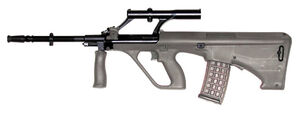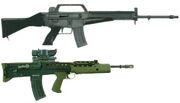
The Steyr AUG is one of the most successful bullpup rifles
Bullpup is a firearm configuration in which the action (or mechanism) and magazine are located behind the trigger. This increases the barrel length relative to the overall weapon length, permitting shorter weapons for the same barrel length, saving weight and increasing maneuverability. It alternatively allows for longer barrels on weapons of the same length, improving trajectory and effective range.

One of the most exotic forms of Bullpup rifles, the Korobov TKB-022PM.
The concept was first used in bolt-action rifles such as the Thorneycroft carbine of 1901, and is known to have been applied to semi-automatic firearms in 1918 (6.5 mm French Faucon-Meunier semi-automatic rifle developed by Lt. Col. Armand-Frédéric Faucon), then in 1936 a bullpup pistol was patented by the Frenchman Henri Delacre. A 7.62 mm caliber experimental assault rifle was developed by Korovin in the Soviet Union in 1945. The United Kingdom had been considering the idea of a bullpup service rifle since 1944. Two designs, the EM-1 and the EM-2 were developed by the British as a replacement for separate pistol, submachine gun and rifle. The choice of bullpup design was a necessity to keep the accuracy up while keeping overall length down. The EM-2 was adopted by the UK in 1951 as the world's first (limited) service bullpup rifle but was promptly displaced by the adoption of the 7.62 x 51 mm NATO cartridge.
Worldwide use[]
Bullpups began to become mainstream military weapons in the late 1970s with the introduction of the Steyr AUG and FAMAS in Austria and France, respectively (the AUG later became the standard issue military rifle for several other countries). In 1985, Great Britain followed suit with the introduction of the SA80. Today, bullpups are common in modern military arsenals, and make up a large minority of military small arms. Recently Israel, Singapore, Iran, and China have all adopted locally-designed and produced bullpup rifles. The new F2000 may be adopted by a number of countries. New bullpup rifles actually outnumber new conventional-layout military rifles designed and introduced in the last several years. Some cite the increasingly urban nature of warfare as a reason for their increased popularity, their short length being useful in CQC (close quarter combat).
Design issues[]

The difference between Traditional (above) and Bullpup (below) rifle layouts. The SA80 (below) retains the barrel length of the SAR-87 (above).
Bullpup weapons have been the subject of some debate and criticism. Mechanisms typically eject casings to the side. This means that a conventional bullpup design must be fired from only one side of the body, or the casings will hit the operator in the face. Some bullpups' designs allow the side of ejection to be switched during disassembly (e.g. the FAMAS, TAR-21 Tavor and Steyr AUG), while others, like the FN F2000, A-91, and Kel-Tec's upcoming RFB, eject forward. Still others, like the FN P90, eject downward, which usually (but not always) means the magazine is mounted on the top or sides of the weapon. The H&K G11 avoided the issue entirely by using caseless ammunition.
Other criticisms made of bullpup weapons are their heavy and sluggish trigger pull, caused by use of a flexible rod or similar system (fixed in the SAR-21 by using a stiff sliding plate instead), awkward magazine changes, poor balance (a bullpup's weight is centered to the rear or directly above the trigger, instead of between the user's hands as in the traditional design), high sight position above the barrel (forcing the firer to expose more of his head when aiming over cover), reduced reach in bayonet fighting, and uncomfortable muzzle blast caused by the muzzle's proximity to the operator's head.
Proponents of bullpups have responses to these criticisms, however: The location of the magazine well makes it easier to change magazines while traveling in an open vehicle. The high sight position is a design feature shared with many modern conventional rifles (like the M16), allows comfortable and accurate shooting posture, and is effective in combatting muzzle climb. Further, muzzle blast is actually less in a bullpup rifle than in a conventional rifle of equal overall length and, just as with the bayonet's range, increasing the barrel length is a simple fix, if the problem is deemed serious enough.
Weapons Similar to Bullpup[]
The term Semi Bullpup has been used to describe similar firearm layouts where the operation is behind the trigger section with the magazine insert/belt feed above the pistol grip. The likes of the Bergmann MG15, FG42, Krieghoff Model 1940, M60, XM235, Spasov M1936, TsKIB and Vickers GO No.2 Mk.1 Land Service are examples of semi bullpup firearms.
The AK-74MB is an experimental dual-format assault rifle, capable of quickly switching from a conventional layout to a bullpup layout.